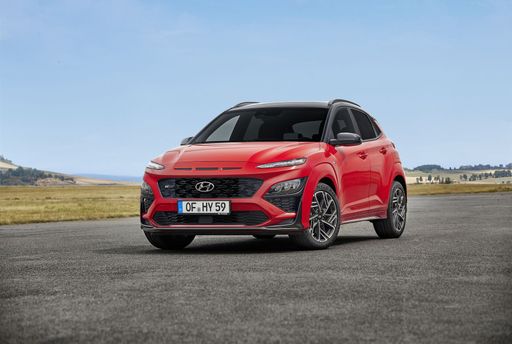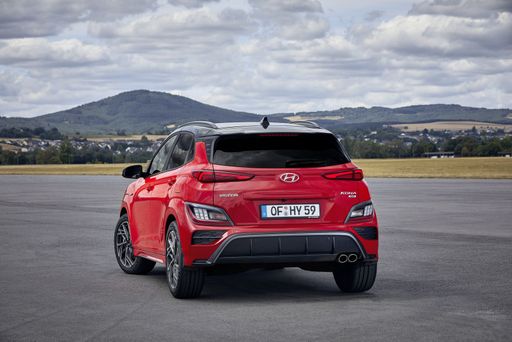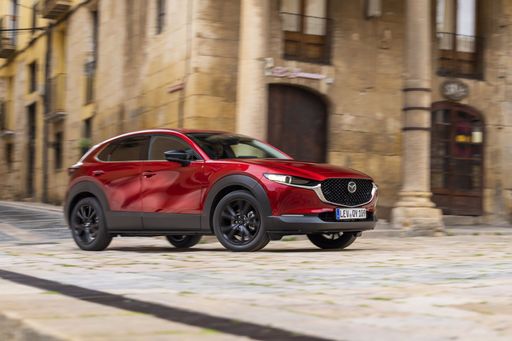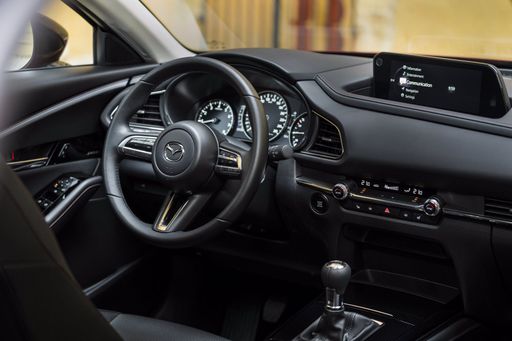When it comes to compact SUVs, the Hyundai Kona and Mazda CX-30 have emerged as two of the most attractive options on the market. Both vehicles boast a plethora of advanced technical features and innovations that promise a delightful driving experience. In this article, we’ll delve into how these two vehicles stack up against each other in various critical aspects, helping you decide which compact SUV suits your needs better.
Hyundai Kona vs Mazda CX-30 – Which car suits you better?
Compare performance, boot capacity, efficiency and price at a glance.
Find out which car is the better choice for you – Hyundai Kona or Mazda CX-30?
Design and Practicality
The Hyundai Kona features a bold design with sharp angles and a distinctive front fascia, making it an eye-catching option on the road. It measures 4,350 mm in length, with a width of 1,825 mm and a height of 1,585 mm, offering a spacious cargo area of 466 liters. The Kona also has a practical five-door configuration, seating up to five occupants comfortably.
On the other hand, the Mazda CX-30 sports a more elegant and refined design, with smoother lines and a more upscale appearance. It is slightly longer at 4,395 mm and has a width of 1,795 mm and a height of 1,540 mm, which contributes to its striking profile. The CX-30 offers a slightly smaller trunk capacity of 430 liters but still provides adequate space for everyday use. Both vehicles have a five-door layout, ensuring easy access for passengers.
Performance and Efficiency
Under the hood, the Hyundai Kona offers multiple engine options, including petrol, full hybrid, and electric variants, with power outputs ranging from 100 to an impressive 218 HP. The Kona is versatile, allowing buyers to choose from front-wheel drive or all-wheel drive configurations. Additionally, it showcases a low fuel consumption rate, with petrol engines averaging between 5.7 to 6.7 L/100km, and an electric range of up to 514 km on a single charge for electric models. The acceleration can be quite brisk too, with certain versions achieving 0-100 km/h in just 7.8 seconds.
In contrast, the Mazda CX-30 is equipped primarily with petrol MHEV engines, providing a maximum power output of 186 HP. The CX-30 offers both front-wheel drive and all-wheel drive options as well. Its fuel efficiency is competitive, with consumption ranging from 5.7 to around 6.6 L/100km. The performance is commendable as well, with the top variants achieving 0-100 km/h in as quick as 8.3 seconds, underlining its sporty character.
Technology and Innovations
The Hyundai Kona comes loaded with the latest technology, featuring a user-friendly infotainment system that includes a touchscreen display, smartphone integration, and various connectivity options. Additionally, advanced safety features such as lane-keeping assist, adaptive cruise control, and a rearview camera enhance the driving experience.
Moreover, the Kona’s hybrid and electric variants introduce an innovative battery management system aimed at maximizing efficiency and minimizing emissions. The electric models also boast a fast-charging capability, making them practical for longer journeys.
Meanwhile, the Mazda CX-30 focuses on driver engagement with its state-of-the-art infotainment system, intuitive controls, and premium audio options. It also prioritizes safety, offering advanced safety features like blind-spot monitoring and rear cross-traffic alert. The Mazda Connect system enhances connectivity, and the car's built quality further reflects attention to detail and craftsmanship.
Conclusion
Choosing between the Hyundai Kona and Mazda CX-30 ultimately depends on your personal preferences and driving needs. The Kona stands out for its versatility with various powertrains, including electric options, as well as spacious cargo capacity. In contrast, the CX-30 excels in delivering a refined driving experience with its stylish design and focus on driver engagement.
Both vehicles embody the growing demand for practical yet sophisticated compact SUVs, making either choice a worthwhile investment. Whether you prioritize innovative technology, performance, or practicality, both the Hyundai Kona and Mazda CX-30 offer compelling reasons to be considered your next vehicle.
Here’s where it gets real: The technical differences in detail
Costs and Efficiency:
Looking at overall running costs, both models reveal some interesting differences in everyday economy.
Hyundai Kona has a barely noticeable advantage in terms of price – it starts at 23100 £, while the Mazda CX-30 costs 25200 £. That’s a price difference of around 2177 £.
Fuel consumption also shows a difference: Hyundai Kona manages with 4.60 L and is therefore distinct more efficient than the Mazda CX-30 with 5.70 L. The difference is about 1.10 L per 100 km.
Engine and Performance:
Power, torque and acceleration are the classic benchmarks for car enthusiasts – and here, some clear differences start to show.
When it comes to engine power, the Hyundai Kona has a a bit edge – offering 218 HP compared to 186 HP. That’s roughly 32 HP more horsepower.
In acceleration from 0 to 100 km/h, the Hyundai Kona is hardly perceptible quicker – completing the sprint in 7.80 s, while the Mazda CX-30 takes 8.30 s. That’s about 0.50 s faster.
In terms of top speed, the Hyundai Kona performs minimal better – reaching 210 km/h, while the Mazda CX-30 tops out at 204 km/h. The difference is around 6 km/h.
There’s also a difference in torque: Hyundai Kona pulls hardly perceptible stronger with 265 Nm compared to 240 Nm. That’s about 25 Nm difference.
Space and Everyday Use:
Whether family car or daily driver – which one offers more room, flexibility and comfort?
Both vehicles offer seating for 5 people.
In curb weight, Hyundai Kona is barely noticeable lighter – 1370 kg compared to 1455 kg. The difference is around 85 kg.
In terms of boot space, the Hyundai Kona offers minimal more room – 466 L compared to 430 L. That’s a difference of about 36 L.
In maximum load capacity, the Mazda CX-30 performs slight better – up to 1406 L, which is about 106 L more than the Hyundai Kona.
When it comes to payload, Mazda CX-30 slight takes the win – 496 kg compared to 490 kg. That’s a difference of about 6 kg.
Who wins the race?
The Hyundai Kona proves to be wins solidly and therefore becomes our DriveDuel Champion!
Hyundai Kona is the better all-rounder in this comparison.
 @ Hyundai Motor Company
@ Hyundai Motor Company
Hyundai Kona
Hyundai Kona
The Hyundai Kona wears its personality on the outside with bold styling and sprightly handling that turns city driving into something a little more fun than a commute. It blends practical space, modern tech and sensible running costs into a compact, stylish package — a smart pick if you want flair without paying luxury prices.
details @ Hyundai Motor Company
@ Hyundai Motor Company
 @ Hyundai Motor Company
@ Hyundai Motor Company
 @ Hyundai Motor Company
@ Hyundai Motor Company
 @ Hyundai Motor Company
@ Hyundai Motor Company
Mazda CX-30
The Mazda CX-30 blends sleek coupe-like lines with the practicality of a compact crossover, feeling more premium than its price tag suggests. It’s a joy to drive for anyone who likes a taut chassis and an interior that treats daily commutes like a small luxury escape.
details @ Mazda Motor Corporation
@ Mazda Motor Corporation
 @ Mazda Motor Corporation
@ Mazda Motor Corporation
 @ Mazda Motor Corporation
@ Mazda Motor Corporation
 @ Mazda Motor Corporation
@ Mazda Motor Corporation
 @ Hyundai Motor Company
@ Hyundai Motor Company
|
 @ Mazda Motor Corporation
@ Mazda Motor Corporation
|
|
|
|
Costs and Consumption |
|
|---|---|
|
Price
23100 - 41600 £
|
Price
25200 - 36800 £
|
|
Consumption L/100km
4.6 - 7 L
|
Consumption L/100km
5.7 - 6.6 L
|
|
Consumption kWh/100km
14.6 - 16.8 kWh
|
Consumption kWh/100km
-
|
|
Electric Range
377 - 514 km
|
Electric Range
-
|
|
Battery Capacity
1.3 - 65.4 kWh
|
Battery Capacity
-
|
|
co2
0 - 163 g/km
|
co2
129 - 148 g/km
|
|
Fuel tank capacity
38 - 47 L
|
Fuel tank capacity
48 - 51 L
|
Dimensions and Body |
|
|---|---|
|
Body Type
SUV
|
Body Type
SUV
|
|
Seats
5
|
Seats
5
|
|
Doors
5
|
Doors
5
|
|
Curb weight
1370 - 1773 kg
|
Curb weight
1455 - 1587 kg
|
|
Trunk capacity
466 L
|
Trunk capacity
422 - 430 L
|
|
Length
4350 - 4385 mm
|
Length
4395 mm
|
|
Width
1825 mm
|
Width
1795 mm
|
|
Height
1580 - 1585 mm
|
Height
1540 mm
|
|
Max trunk capacity
1300 L
|
Max trunk capacity
1398 - 1406 L
|
|
Payload
420 - 490 kg
|
Payload
458 - 496 kg
|
Engine and Performance |
|
|---|---|
|
Engine Type
Electric, Petrol, Full Hybrid
|
Engine Type
Petrol MHEV
|
|
Transmission
Automatic, Manuel
|
Transmission
Manuel, Automatic
|
|
Transmission Detail
Reduction Gearbox, Manual Gearbox, Dual-Clutch Automatic
|
Transmission Detail
Manual Gearbox, Automatic Gearbox
|
|
Drive Type
Front-Wheel Drive, All-Wheel Drive
|
Drive Type
Front-Wheel Drive, All-Wheel Drive
|
|
Power HP
115 - 218 HP
|
Power HP
140 - 186 HP
|
|
Acceleration 0-100km/h
7.8 - 11.9 s
|
Acceleration 0-100km/h
8.3 - 10.3 s
|
|
Max Speed
162 - 210 km/h
|
Max Speed
191 - 204 km/h
|
|
Torque
200 - 265 Nm
|
Torque
238 - 240 Nm
|
|
Number of Cylinders
3 - 4
|
Number of Cylinders
4
|
|
Power kW
85 - 160 kW
|
Power kW
103 - 137 kW
|
|
Engine capacity
998 - 1598 cm3
|
Engine capacity
1998 - 2488 cm3
|
General |
|
|---|---|
|
Model Year
2024 - 2025
|
Model Year
2025
|
|
CO2 Efficiency Class
A, D, C, E, F
|
CO2 Efficiency Class
D, E
|
|
Brand
Hyundai
|
Brand
Mazda
|
Is the Hyundai Kona offered with different drivetrains?
Available configurations include Front-Wheel Drive or All-Wheel Drive.
The prices and data displayed are estimates based on German list prices and may vary by country. This information is not legally binding.
